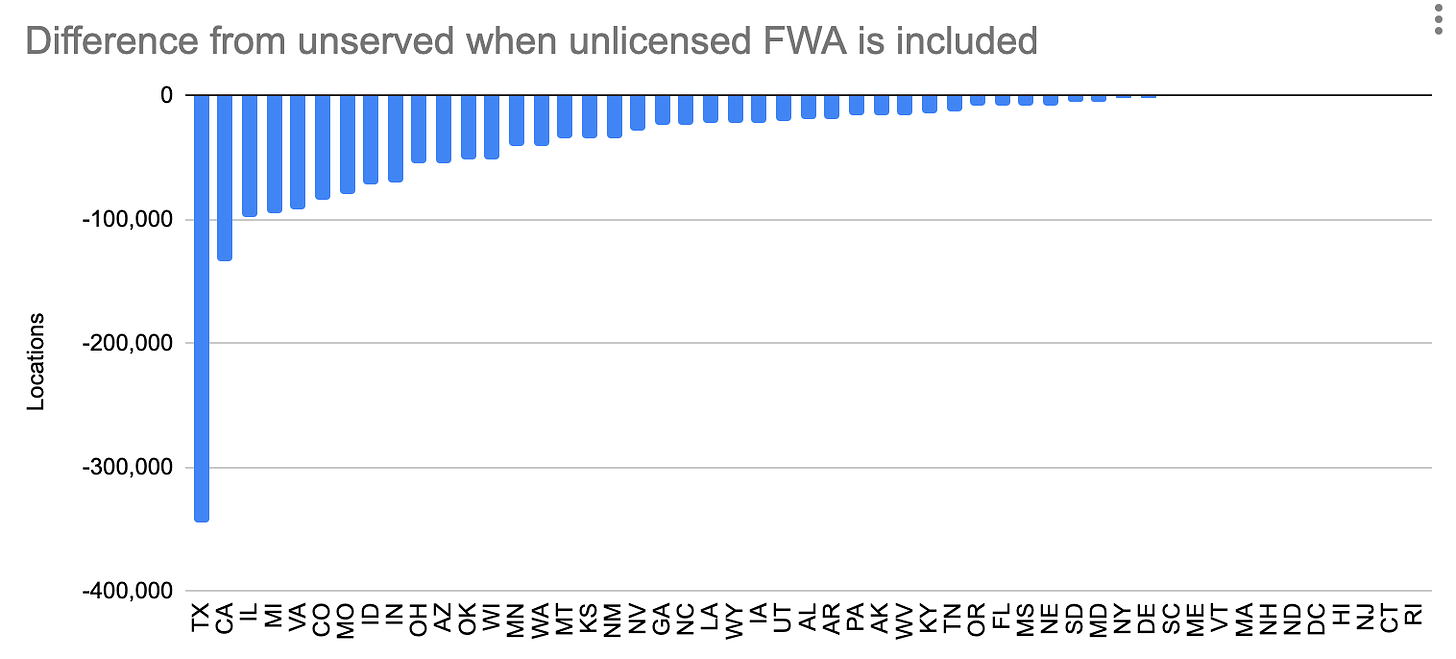When the new FCC maps came out, we were quick to compare the number of unserved locations in the new maps to the number of unserved housing units in the previous Form 477 data. As expected, the number of unserved locations doubled, from 3.6 million to 7.8 million. But that comparison isn’t apples-to-apples. The Form 477 data includes fixed wireless access (FWA) delivered over unlicensed spectrum (in fact there’s no way to distinguish) while the BEAD program, which is the de facto new definition of broadband, excludes fixed wireless delivered over unlicensed spectrum. The denominator is the same, but the numerators are different. Were unlicensed fixed wireless to be included, there would only be 6 million unserved locations, 23% fewer than the official definition.
In the chart below, we see how locations would change with the inclusion of FWA in unlicensed spectrum. Almost 700,000 locations that are officially defined as unserved in the new maps would be served (100/20 or better) if licensed FWA were included. 975,000 of the unserved would move to underserved. And 6 million of the original 7.8 million locations would remain unserved.
Under this definition, the biggest states would lose the most, but rural states would also be affected. Texas would have 344,000 fewer unserved locations and California would have 134,000 fewer. But Colorado would have 83,000 fewer, Idaho would have 72,000 fewer, and Oklahoma would have 52,000 fewer. In small states, swings of that size would have dramatic consequences on overall BEAD allocations.
“Tech neutrality”, the idea that we should accept any technology that can deliver the threshold throughput, has become a flashpoint. The effect of the current definition is states will get allocations that include these 1.8 million locations as unserved, and those 1.8 million locations are more likely (though not certain, depending on state rules) to get a federally-subsidized fiber network at some point in the future. It seems to me that everyone comes up as a winner, except the existing FWA network operator.
If you agree these 1.8 million locations are correctly excluded from the BEAD definition, the question works the same in reverse: what locations are included in the official BEAD definition that perhaps shouldn’t be? These are locations where the state may want to help build a network, and may want funding based on those locations. I did an entire post on this, finding that there are 2 million locations where DSL or licensed FWA of exactly 25/3 is making a location underserved instead of unserved.
Here’s the same chart as above, except instead of hypothetically including unlicensed FWA, we hypothetically exclude all DSL service. In this scenario, 1.1 million locations that are officially served or underserved at 25/3 or better would become unserved. Included in that group are 131,000 locations that would be unserved but for the presence of a DSL network with a “maximum advertised speed” of 100/20 or better.
“Technological neutrality” advocates would have us ignore the the type of technology used and focus instead on the “maximum advertised speed”. For the sake of those unserved and underserved by broadband, I’d run in the opposite direction.






Good posting as usual, but I do not agree with this comment: “Technological neutrality” advocates would have us ignore the the type of technology used and focus instead on the “maximum advertised speed”.
I think we can agree that advertised speeds can be an issue and for all technologies, especially fixed wireless but even including fiber. However, we can have tech neutral policy and focus on delivered or deliverable speeds, not just maximum advertised speeds. Thanks.
That's a hard thing to call. We should not focus exclusively on "maximum advertised speed" in part because it tends to be overstated, but more important because there are other metrics to consider, especially latency and reliability. The Broadband Forum has created a metric called a "Quality-of-Experience Index" that might be a good objective to focus on (I haven't gotten too deeply into it, so can't recommend it.)
All unlicensed FWA is not created alike. The latest technology, like the Tarana Wireless gear that NextLink is using for part of their RDOF build, is actually quite good, albeit expensive. So, I understand, is the unlicensed mmWave gear like Adtran/CCS and Terragraph. It shouldn't be lumped with WiMax or outdoor WiFi. I suspect that bad experience with WISPs using that technology and maybe lacking engineering expertise has poisoned a lot of people's opinions of unlicensed FWA.
Ditto DSL. Most of it is dismal. But there are pockets of VDSL that can easily clear the 25/3 bar, and even some that can do 100/10. There's not a lot of G.fast on this side of the Atlantic, but in parts of Europe, it is providing close to 1 Gbps downstream. Not to advise giving BEAD funding to Tier-3 telcos to upgrade their ADSL+ to bonded VDSL or G.fast. But it's hard to think of a principled techical reason to preclude it, either.
There's also the question of CBRS General Availability Licenses.
Wish I had time to get more deeply into this.